
Mauritia flexuosa, known as the moriche palm, ité palm, ita, buriti, muriti, miriti, canangucho (Colombia), or aguaje (Peru), is a palm tree. It grows in and near swamps and other wet areas in tropical South America. It has been reported from Trinidad, Colombia, Venezuela, Guyana, Suriname, French Guiana, Brazil, Ecuador, Peru, and Bolivia.

Agonis is a genus in the plant family Myrtaceae. All are endemic to Western Australia, growing near the coast in the south west.

Agonis flexuosa is a species of tree that grows in the south west of Western Australia. It is easily the most common of the Agonis species, and is one of the most recognisable trees of Western Australia, being commonly grown in parks and on road verges in Perth.
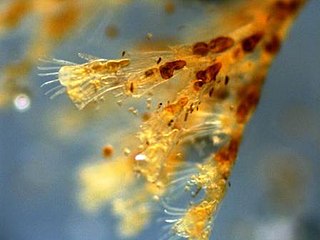
Campanulariidae is a family of animals in the phylum Cnidaria, or stinging-celled animals. Campanulariidae is composed entirely of hydroids, a Greek term meaning "water animals" applied to the plant-like polyp colonies of the class Hydrozoa. All species of the Campanulariidae are aquatic in habitat, primarily inhabiting coastal regions and tidal pools.

Grevillea flexuosa, commonly known as zigzag grevillea or tangled grevillea, is an endangered shrub endemic to Western Australia.

Deschampsia flexuosa, commonly known as wavy hair-grass, is a species of bunchgrass in the grass family widely distributed in Eurasia, Africa, South America, and North America.

The Conscience Point National Wildlife Refuge was established July 20, 1971 as a land gift from Stanley Howard. The 60-acre (24 ha) refuge is located in the hamlet of North Sea on the north shore of Long Island's south fork. The refuge protects grasslands, oak-beech forest, shrub habitats, kettle holes, freshwater marsh and salt marsh.
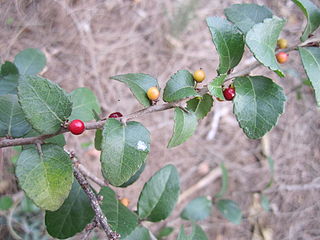
Xylosma flexuosa, commonly known as brushholly or coronilla, is a species of flowering plant in the willow family, Salicaceae, that is native to southern North America and northern South America. Its range stretches from southern Texas in the United States south through Mexico and Central America to Venezuela. It can also be found on the island of Curaçao in the Netherlands Antilles. Brush holly is a spiny evergreen shrub, usually reaching a height of 1–2 m (3.3–6.6 ft) but able to attain 6–8 m (20–26 ft) in height. Red and yellow berries around 7–8 mm (0.28–0.31 in) in diameter are found on the plant throughout the year. It is sometimes cultivated as an ornamental hedge.

Joshua Alder was a British cheesemonger and amateur zoologist and malacologist. As such, he specialized in the Tunicata, and in gastropods.
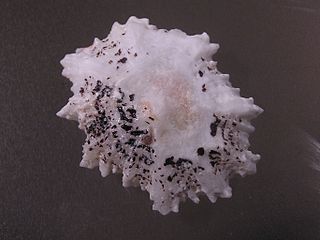
Scutellastra flexuosa is a species of sea snail, a true limpet, a marine gastropod mollusk in the family Patellidae, one of the families of true limpets.

Vitis flexuosa is a species of liana in the grape family.
Flexuosa, meaning "full of bends" in Latin, may refer to:

Flexuosol A is a resveratrol tetramer found in Vitis flexuosa.
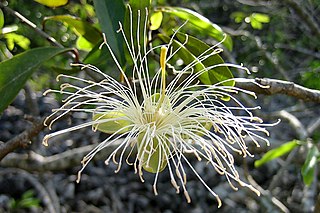
Cynophalla flexuosa is a 2–4 meter high shrub.
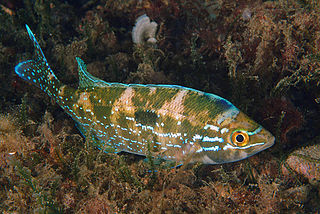
Spicara is a genus of picarels native to the eastern Atlantic Ocean and the western Indian Ocean.
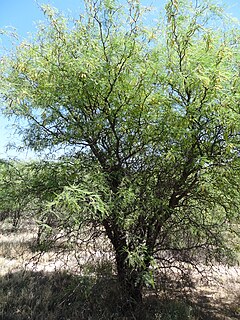
Prosopis flexuosa, commonly known as tortuous mesquite and a variety of Spanish vernacular names including algarrobo dulce and algarrobo negro, is a species of flowering tree in the genus Prosopis of the family Fabaceae. It is found in arid and semi-arid regions of Argentina, Bolivia and Chile, including the western Gran Chaco and the Monte Desert, where it is a conspicuous and characteristic plant of the region. Its timber is used for construction, charcoal and fuel and its fruits are eaten by humans and livestock.
Synaphea flexuosa is a shrub endemic to Western Australia.
Morisonia is a genus of flowering plants in the family Capparaceae, found across the Americas from the United States to Argentina. It was recently enlarged with New World Capparis species due to existing taxonomic instability. They tend to be shrubs or small trees.
Laomedea is a genus of Cnidaria of the family Leptothecata. The genus was described by Lamouroux in 1812.













